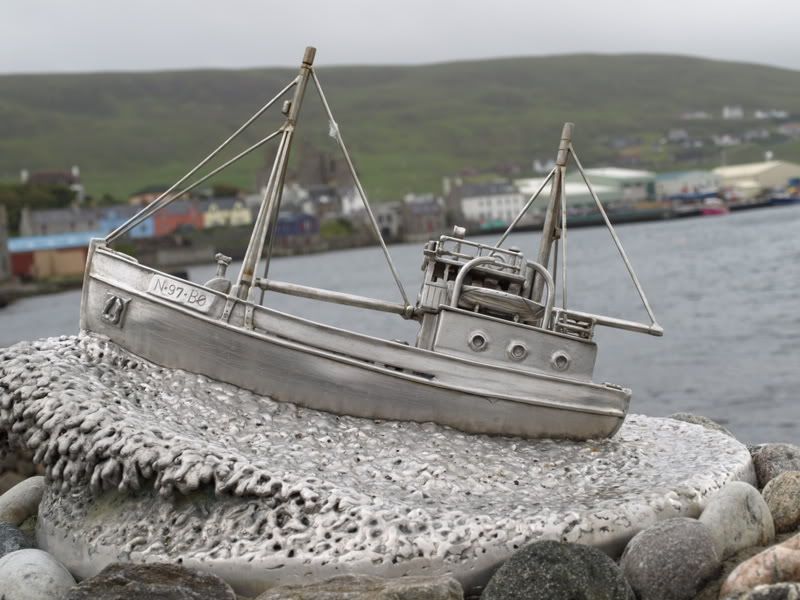When war broke out in September 1939 the islanders of Shetland probably thought that it would be unlikely that the actions of Hitler's Germany would impact them directly. They were a long way from Poland and the battlefields of Europe. Even the naval blockade of the North Sea would be operated from Scapa Flow in the Orkney Islands further south.
The events of Spring 1940 changed all that; Norway was invaded by the Germans and a hastily assembled British and French expeditionary force was beaten back home with their tails between their legs.
By the summer of 1940 the Germans may have been in charge in Norway and had a few tame collaborators like Vidkun Quisling to help them but there were many brave Norwegians who were ready to resist.
It is often quoted that Oslo is nearer Shetland than London; and so it was to the Northern Isles where the Norwegian section of the Special Operations Executive looked to when they were wanting a base for incursions into Norway. They went to Lunna near Lerwick first, but then moved to a purpose built pier at Scalloway.
Using Norwegian fishing boats crewed by a mix of fishermen and sailors who knew the coasts of Norway like the backs of their hands the SOE ran agents and supplies into Norway. They returned with intelligence, volunteers and men and women in danger of arrest by the Nazis. In 1943 the heavy losses of fishing boats led to the US Navy lending them three fast submarine chasers, and the civilian volunteer crews joined the Royal Norwegian Navy. With their new boats there were no more losses.
Between August 1941 and May 1945 the SOE ran 198 operations across the North Sea. 44 men of the operation died in those three and a half years but through their sacrifice they landed 192 agents and 383 tons of weapon and supplies in Norway. They had retuned with 73 agents and 373 refugees.
Throughout the war years the already close relationship between Shetland and Norway was strengthened further. Today on Scalloway's Main Street a magnificent memorial to the Norwegians of the Shetland Bus shows a small fishing boat battling the sea. It is a fitting subject. At night and in winter it was a perilous journey across the North Sea, but German patrol ships and aircraft added extra perils for these brave volunteers
The events of Spring 1940 changed all that; Norway was invaded by the Germans and a hastily assembled British and French expeditionary force was beaten back home with their tails between their legs.
By the summer of 1940 the Germans may have been in charge in Norway and had a few tame collaborators like Vidkun Quisling to help them but there were many brave Norwegians who were ready to resist.
It is often quoted that Oslo is nearer Shetland than London; and so it was to the Northern Isles where the Norwegian section of the Special Operations Executive looked to when they were wanting a base for incursions into Norway. They went to Lunna near Lerwick first, but then moved to a purpose built pier at Scalloway.
Using Norwegian fishing boats crewed by a mix of fishermen and sailors who knew the coasts of Norway like the backs of their hands the SOE ran agents and supplies into Norway. They returned with intelligence, volunteers and men and women in danger of arrest by the Nazis. In 1943 the heavy losses of fishing boats led to the US Navy lending them three fast submarine chasers, and the civilian volunteer crews joined the Royal Norwegian Navy. With their new boats there were no more losses.
Between August 1941 and May 1945 the SOE ran 198 operations across the North Sea. 44 men of the operation died in those three and a half years but through their sacrifice they landed 192 agents and 383 tons of weapon and supplies in Norway. They had retuned with 73 agents and 373 refugees.
Throughout the war years the already close relationship between Shetland and Norway was strengthened further. Today on Scalloway's Main Street a magnificent memorial to the Norwegians of the Shetland Bus shows a small fishing boat battling the sea. It is a fitting subject. At night and in winter it was a perilous journey across the North Sea, but German patrol ships and aircraft added extra perils for these brave volunteers
On this day seventy years ago the defeat of Germany would have seemed a long way off. But for the brave Norwegians of the Shetland Bus their first mission from Lunna Voe on 30th August 1941 would mean the liberation of their country would happen that little bit sooner.

No comments:
Post a Comment